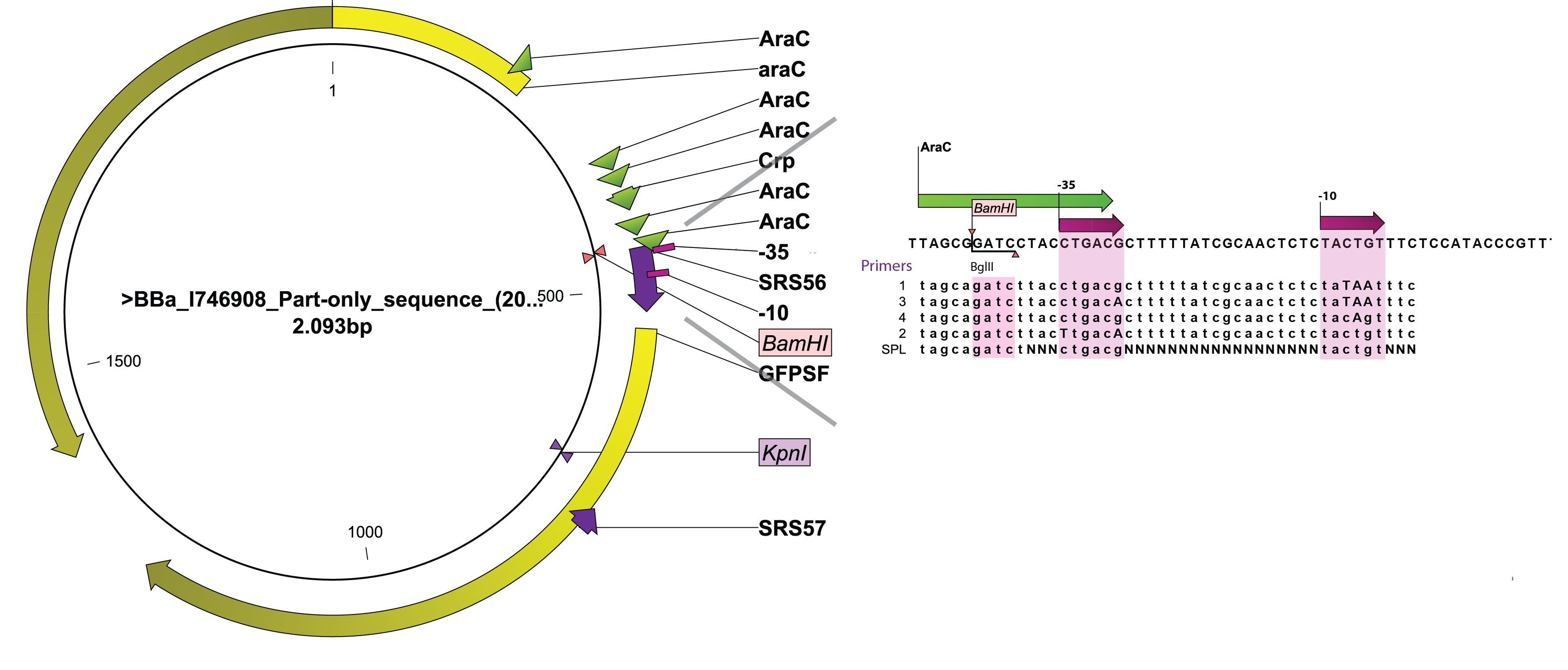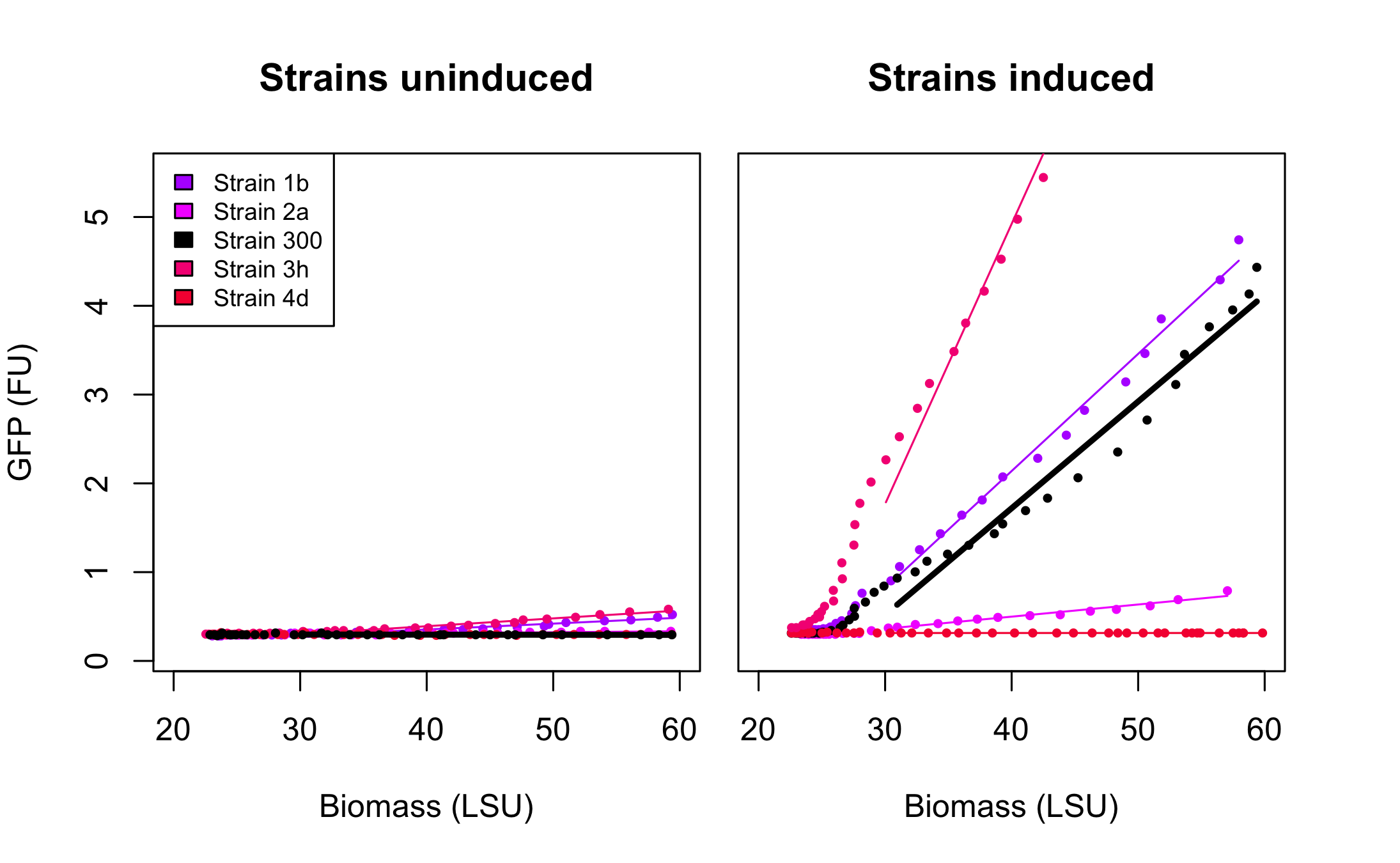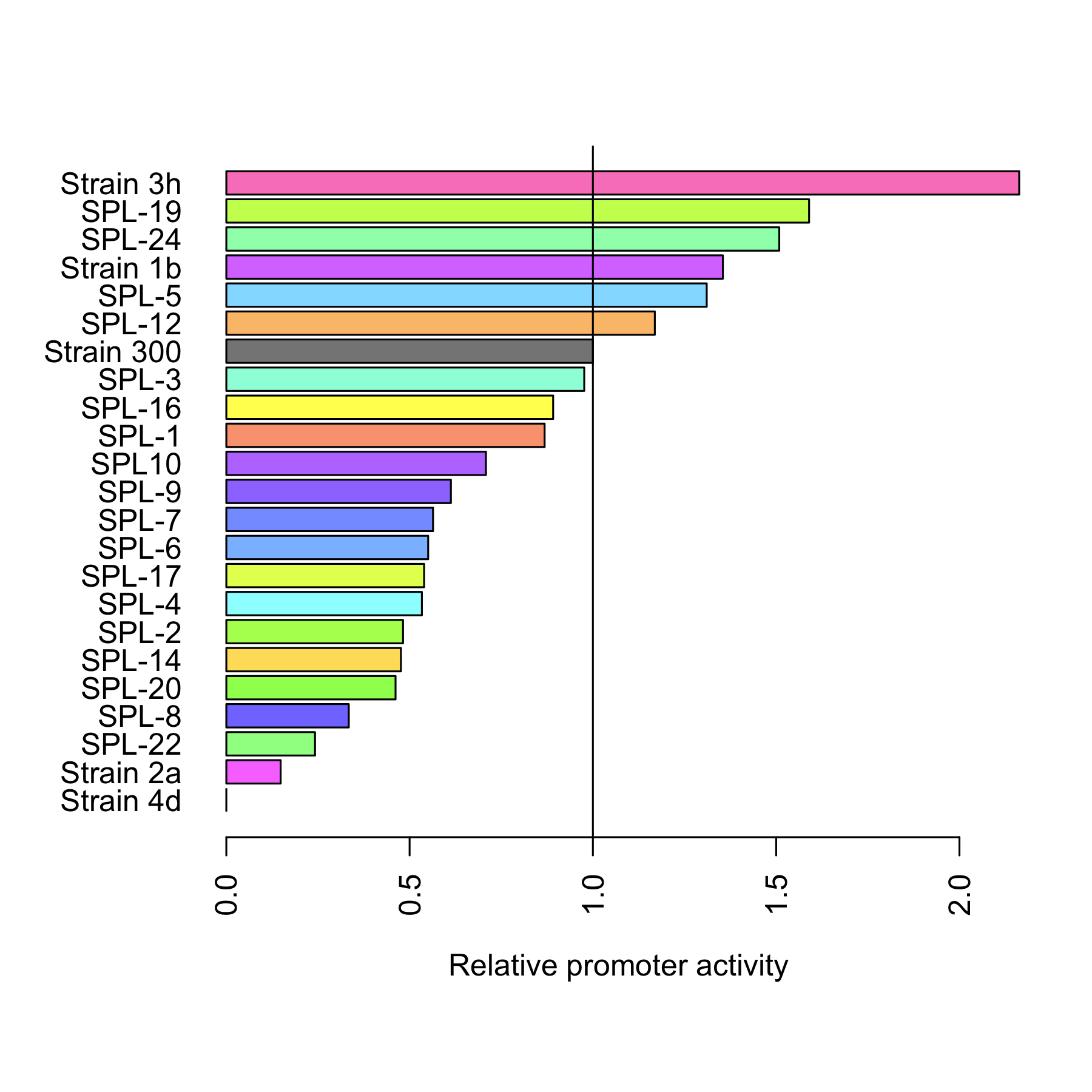Team:DTU-Denmark/Project improving araBAD
From 2011.igem.org
Experiment: Improving araBAD
Contents |
The araBAD promoter (BBa-I0500)
In our project to control sRNA chiXR expression we used the arabinose promoter (PBAD) from the araBAD operon that is regulated by the AraC protein[10]. AraC can work both as a repressor and activator of PBAD. In the absence of arabinose, AraC represses transcription from PBAD while a conformational change turns it into an activator in the presence of arabinose. In addition, the promoter is subject to catabolite rerpession and is thus further repressed in the presence of glucose.
PBAD is a very frequently used promoter because of its extreme tightness. In the presence of glucose, this promoter triggers negligible amount of transcription which allows cloning of toxic genes downstream of it however it is also relatively weak even upon full induction preventing high level expression which could be necessary for protein purification for example. Even though the response of the PBAD promoter appears graded to inducer concentration at the population level[7][10], it has been demonstrated that this is not the case at the individual cell level[6] where is displays an "all or nothing" behaviors with cells being either completely "OFF" or fully "ON" and only the fraction of OFF/ON cells varying upon arabinose concentration modification. induction of cell culture is one of them. As a result only a subset of cells becomes induced with the arabinose. This can be very problematic when trying to express poorly soluble functions or when working at the single cell level. This "all or nothing" behavior stems from the arabinose transporters being also positively regulated by arabinose. Upon entry of a little bit of inducer, a feed forward loop sets in where transporters are strongly upregulated as they bring more and more arabinose into the cell until the inducer is exhausted in teh immediate vicinity of the cell and the systems turns off. To circumvent this pitfall, researchers have devised strains which are constitutively permissive for arabinose entry thus breaking teh feed forward loop. Such approaches however necessitate the introduction of many mutations inside a strain and is therefore difficult to implement in other microbes but E. coli where the strains already exist[7] [11]. Besides, if an intermediate level of induction is required for a system to be optimal, reproducibly adding the exact precise concentration of arabinose in the culture can a significant hurdle.
We have approached the problem through another angle. If it is difficult to obtain reproducible results by changing the inducer concentration, why not try and change the promoter strength and systemaically use a saturating amount of inducer? Our approach was therefore based on last year's iGEM DTU team work on Synthetic Promoter Libraries but applied to an inducible promoter. In the process we were also hoping to obtain stronger than wild-type, but arabinose regulated promoters which could better match other induced system like the Ptet promoter PLEASE add this https://www-ncbi-nlm-nih-gov.globalproxy.cvt.dk/pubmed/21261817 reference here or the prompionate induced PprpB[8]</span>[10].
Approach
Since control of the system is essential to the applicability of our system we attempted to modify the dynamic range of the arabinose promoter ([http://partsregistry.org/Part:BBa_I0500 BBa_I0500]) by two means:
- rationally designing the -10 and -35 sequences of the promoter region since both the -35 (CTGACG) and the -10 (TACTGT) of the arabinose promoter are far from the consensus (TTGACA and TATAAT respectively) thus potentially explaining its weakness.
- randomizing all nucleotides between the -10 and the -35 boxes as well as a few residues on each side thus creating Synthetic Promoter Library (SPL) similar to that described in [1] but without any modification to the natural -10 and -35 from BBa-I0500.
SPL require screening fo a relatively number of colonies to obtain a representative idea of the promoter diversity generated. We therefore wanted to take advantage of the BioLector aparatus available on campus. Indeed, this highly parallel micro fermentor allows testing 24 colonies at a time with minimal human interference. As a consequence, we sought for an existing PBAD regulated GFP or RFP within the registry as their activity can be measured by our machine. We turned to BBa_I746908[http://partsregistry.org/Part:BBa_I746908 BBa_I746908] created by the Cambridge team in 2008. A rapid look through the sequence of BBa_I746908identified two unique restriction sites that could be used to levitate the existing wild-type promoter and replace it by engineered variants, BamHI, located immediately upstream of the -35 box and KpnI, within the GFP gene. A PCR primer (SRS57) was designed to anneal downstream of the KpnI and amplify the 3' end of GFP in conjunction with 5 different primers designed to overlap the arabinose promoter and introduce the changes (SRS56-1, -2, -3, -4, and SPL). SRS56 also features a BglII site in place of the natural BamHI site so that proper mutants could be easily screened out after ligation and transformation. Correct clones were found for each rationally modified PBAD and 17 individual BamHI resistant clones of the SPL were analysed in the BioLector.
Detailed description of the experiments, including information on primers used, can be found in labnotebook.
Results
All 4 rationally designed (in strains called 1b, 2a, 3h, 4d) and 18 SPL-changed arabinose promoters (in strains called SPL-1 up to SPL-24) fused to GFP were tested under induction of arabinose at concentration 0.2% and compared to non-induced state. Also, the original [http://partsregistry.org/Part:BBa_I746908 BBa_I746908], in strain strain 300, was characterized in the same fashion. In all the figures the GFP expression and the biomass concentration are expressed in fluorescence unit (FU) and light scattering unit (LSU) respectively.
Figure 1 presents the characterization for the rationally designed arabinose promoters. When uninduced (left part of the figure) the background GFP expression level for strains 1b and 3h is slightly above the background in original promoter (black line) which indicates that these promoters are less tight. In case of strains 2a and 4d the basal expression level is comparable to the original promoter. From the right part of the figure we can see that the induction didn't influence expression in strain 4d which implies that mutations abolished arabinose regulation in that promoter. In case of strain 2a induction is maintained, however its level is much lower than that of original promoter. The mutations increased the promoter strength in strain 1b and 3h when compared to strain 300.
Figure 2 presents the characterization for the arabinose promoters changed using SPL. At the uninduced state (left part of the figure) the basal expression of all promoters is at the same level as that of original promoter. In the induced state however, the differences in the levels of GFP expression varies significantly with some of the promoters being more active and others less active than the original promoter in strain 300.
References
[1] Datta, Simanti, Nina Costantino, and Donald L Court. “A set of recombineering plasmids for gram-negative bacteria.” Gene 379 (September 1, 2006): 109-15. http://www.ncbi.nlm.nih.gov/pubmed/16750601.
[2] Figueroa-Bossi, Nara, Martina Valentini, Laurette Malleret, and Lionello Bossi. “Caught at its own game: regulatory small RNA inactivated by an inducible transcript mimicking its target.” Genes & Development 23, no. 17 (2009): 2004 -2015.
[3] Hayashi, Koji, Naoki Morooka, Yoshihiro Yamamoto, Katsutoshi Fujita, Katsumi Isono, Sunju Choi, Eiichi Ohtsubo, et al. “Highly accurate genome sequences of Escherichia coli K-12 strains MG1655 and W3110.” Molecular Systems Biology 2 (2006): 2006.0007. http://www.ncbi.nlm.nih.gov/pubmed/16738553.
[4] Lambert, Jolanda M, Roger S Bongers, and Michiel Kleerebezem. “Cre-lox-based system for multiple gene deletions and selectable-marker removal in Lactobacillus plantarum.” Applied and environmental microbiology 73, no. 4 (February 2007): 1126-35. http://www.pubmedcentral.nih.gov/articlerender.fcgi?artid=1828656&tool=pmcentrez&rendertype=abstract.
[5] Overgaard, Martin, Jesper Johansen, Jakob Møller‐Jensen, and Poul Valentin‐Hansen. “Switching off small RNA regulation with trap‐mRNA.” Molecular Microbiology 73, no. 5 (September 2009): 790-800.
[6] Novick, A. & Weiner, M. “Enzyme induction as an all-or-none phenomenon“ Proc. Natl. Acad. Sci. USA 43 (1957), 533–556.
[7] Khlebnikov, A., K. Datsenko, T. Skaug, B. L. Wanner, and J. D. Keasling. “Homogeneous expression of the P(BAD) promoter in Escherichia coli by constitutive expression of the low-affinity high-capacity AraE transporter.” Microbiology (Reading, England) 147, no. Pt 12 (December 2001): 3241-7. http://www.ncbi.nlm.nih.gov/pubmed/11739756.
[8] Lee, Sung Kuk, and Jay D Keasling. “A Propionate-Inducible Expression System for Enteric Bacteria.” Society 71, no. 11 (2005): 6856-6862.
[9] Lee, Sung Kuk, and Jay D Keasling. “Propionate-Regulated High-Yield Protein Production in Escherichia coli.” Biotechnology (2005).
[10] Guzman, L M, D Belin, M J Carson, and J Beckwith. “Tight regulation, modulation, and high-level expression by vectors containing the arabinose PBAD promoter.” Journal of bacteriology 177, no. 14 (July 1995): 4121-30. http://www.pubmedcentral.nih.gov/articlerender.fcgi?artid=177145&tool=pmcentrez&rendertype=abstract.
[11] Morgan-Kiss, Rachael M, Caryn Wadler, and John E Cronan. “Long-term and homogeneous regulation of the Escherichia coli araBAD promoter by use of a lactose transporter of relaxed specificity.” Proceedings of the National Academy of Sciences of the United States of America 99, no. 11 (May 28, 2002): 7373-7. http://www.pubmedcentral.nih.gov/articlerender.fcgi?artid=124238&tool=pmcentrez&rendertype=abstract.
[12] Rasmussen, Anders Aamann, Jesper Johansen, Jesper S Nielsen, Martin Overgaard, Birgitte Kallipolitis, and Poul Valentin‐Hansen. “A conserved small RNA promotes silencing of the outer membrane protein YbfM.” Molecular Microbiology 72, no. 3 (May 2009): 566-577.
[13] Alper, Hal, Curt Fischer, Elke Nevoigt, and Gregory Stephanopoulos. “Tuning genetic control through promoter engineering.” Proceedings of the National Academy of Sciences of the United States of America 102, no. 36 (2005): 12678 -12683. http://www.pnas.org/content/102/36/12678.abstract.
 "
"













